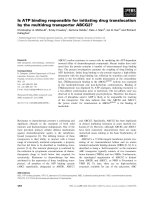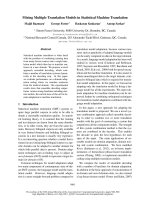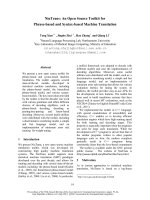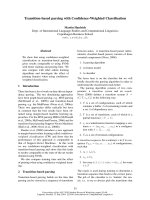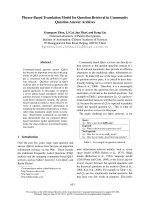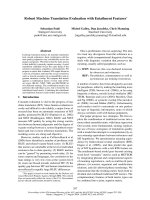Báo cáo khoa học: "Is Machine Translation Ripe for Cross-lingual Sentiment Classification" pdf
Bạn đang xem bản rút gọn của tài liệu. Xem và tải ngay bản đầy đủ của tài liệu tại đây (107.09 KB, 5 trang )
Proceedings of the 49th Annual Meeting of the Association for Computational Linguistics:shortpapers, pages 429–433,
Portland, Oregon, June 19-24, 2011.
c
2011 Association for Computational Linguistics
Is Machine Translation Ripe for Cross-lingual Sentiment Classification?
Kevin Duh and Akinori Fujino and Masaaki Nagata
NTT Communication Science Laboratories
2-4 Hikari-dai, Seika-cho, Kyoto 619-0237, JAPAN
{kevin.duh,fujino.akinori,nagata.masaaki}@lab.ntt.co.jp
Abstract
Recent advances in Machine Translation (MT)
have brought forth a new paradigm for build-
ing NLP applications in low-resource scenar-
ios. To build a sentiment classifier for a
language with no labeled resources, one can
translate labeled data from another language,
then train a classifier on the translated text.
This can be viewed as a domain adaptation
problem, where labeled translations and test
data have some mismatch. Various prior work
have achieved positive results using this ap-
proach.
In this opinion piece, we take a step back and
make some general statements about cross-
lingual adaptation problems. First, we claim
that domain mismatch is not caused by MT
errors, and accuracy degradation will occur
even in the case of perfect MT. Second, we ar-
gue that the cross-lingual adaptation problem
is qualitatively different from other (monolin-
gual) adaptation problems in NLP; thus new
adaptation algorithms ought to be considered.
This paper will describe a series of carefully-
designed experiments that led us to these con-
clusions.
1 Summary
Question 1: If MT gave perfect translations (seman-
tically), do we still have a domain adaptation chal-
lenge in cross-lingual sentiment classification?
Answer: Yes. The reason is that while many trans-
lations of a word may be valid, the MT system might
have a systematic bias. For example, the word “awe-
some” might be prevalent in English reviews, but in
translated reviews, the word “excellent” is generated
instead. From the perspective of MT, this translation
is correct and preserves sentiment polarity. But from
the perspective of a classifier, there is a domain mis-
match due to differences in word distributions.
Question 2: Can we apply standard adaptation algo-
rithms developed for other (monolingual) adaptation
problems to cross-lingual adaptation?
Answer: No. It appears that the interaction between
target unlabeled data and source data can be rather
unexpected in the case of cross-lingual adaptation.
We do not know the reason, but our experiments
show that the accuracy of adaptation algorithms in
cross-lingual scenarios have much higher variance
than monolingual scenarios.
The goal of this opinion piece is to argue the need
to better understand the characteristics of domain
adaptation in cross-lingual problems. We invite the
reader to disagree with our conclusion (that the true
barrier to good performance is not insufficient MT
quality, but inappropriate domain adaptation meth-
ods). Here we present a series of experiments that
led us to this conclusion. First we describe the ex-
periment design (§2) and baselines (§3), before an-
swering Question 1 (§4) and Question 2 (§5).
2 Experiment Design
The cross-lingual setup is this: we have labeled data
from source domain S and wish to build a sentiment
classifier for target domain T . Domain mismatch
can arise from language differences (e.g. English vs.
translated text) or market differences (e.g. DVD vs.
Book reviews). Our experiments will involve fixing
429
T to a common testset and varying S. This allows us
to experiment with different settings for adaptation.
We use the Amazon review dataset of Pretten-
hofer (2010)
1
, due to its wide range of languages
(English [EN], Japanese [JP], French [FR], Ger-
man [DE]) and markets (music, DVD, books). Un-
like Prettenhofer (2010), we reverse the direction of
cross-lingual adaptation and consider English as tar-
get. English is not a low-resource language, but this
setting allows for more comparisons. Each source
dataset has 2000 reviews, equally balanced between
positive and negative. The target has 2000 test sam-
ples, large unlabeled data (25k, 30k, 50k samples
respectively for Music, DVD, and Books), and an
additional 2000 labeled data reserved for oracle ex-
periments. Texts in JP, FR, and DE are translated
word-by-word into English with Google Translate.
2
We perform three sets of experiments, shown in
Table 1. Table 2 lists all the results; we will interpret
them in the following sections.
Target (T ) Source (S)
1 Music-EN Music-JP, Music-FR, Music-DE,
DVD-EN, Book-EN
2 DVD-EN DVD-JP, DVD-FR, DVD-DE,
Music-EN, Book-EN
3 Book-EN Book-JP, Book-FR, Book-DE,
Music-EN, DVD-EN
Table 1: Experiment setups: Fix T , vary S.
3 How much performance degradation
occurs in cross-lingual adaptation?
First, we need to quantify the accuracy degrada-
tion under different source data, without consider-
ation of domain adaptation methods. So we train
a SVM classifier on labeled source data
3
, and di-
rectly apply it on test data. The oracle setting, which
has no domain-mismatch (e.g. train on Music-EN,
test on Music-EN), achieves an average test accu-
racy of (81.6 + 80.9 + 80.0)/3 = 80.8%
4
. Aver-
1
/>2
This is done by querying foreign words to build a bilingual
dictionary. The words are converted to tfidf unigram features.
3
For all methods we try here, 5% of the 2000 labeled source
samples are held-out for parameter tuning.
4
See column EN of Table 2, Supervised SVM results.
age cross-lingual accuracies are: 69.4% (JP), 75.6%
(FR), 77.0% (DE), so degradations compared to or-
acle are: -11% (JP), -5% (FR), -4% (DE).
5
Cross-
market degradations are around -6%
6
.
Observation 1: Degradations due to market and
language mismatch are comparable in several cases
(e.g. MUSIC-DE and DVD-EN perform similarly
for target MUSIC-EN). Observation 2: The ranking
of source language by decreasing accuracy is DE >
FR > JP. Does this mean JP-EN is a more difficult
language pair for MT? The next section will show
that this is not necessarily the case. Certainly, the
domain mismatch for JP is larger than DE, but this
could be due to phenomenon other than MT errors.
4 Where exactly is the domain mismatch?
4.1 Theory of Domain Adaptation
We analyze domain adaptation by the concepts of
labeling and instance mismatch (Jiang and Zhai,
2007). Let p
t
(x, y) = p
t
(y|x)p
t
(x) be the target
distribution of samples x (e.g. unigram feature vec-
tor) and labels y (positive / negative). Let p
s
(x, y) =
p
s
(y|x)p
s
(x) be the corresponding source distribu-
tion. We assume that one (or both) of the following
distributions differ between source and target:
• Instance mismatch: p
s
(x) = p
t
(x).
• Labeling mismatch: p
s
(y|x) = p
t
(y|x).
Instance mismatch implies that the input feature
vectors have different distribution (e.g. one dataset
uses the word “excellent” often, while the other uses
the word “awesome”). This degrades performance
because classifiers trained on “excellent” might not
know how to classify texts with the word “awe-
some.” The solution is to tie together these features
(Blitzer et al., 2006) or re-weight the input distribu-
tion (Sugiyama et al., 2008). Under some assump-
tions (i.e. covariate shift), oracle accuracy can be
achieved theoretically (Shimodaira, 2000).
Labeling mismatch implies the same input has
different labels in different domains. For exam-
ple, the JP word meaning “excellent” may be mis-
translated as “bad” in English. Then, positive JP
5
See “Adapt by Language” columns of Table 2. Note
JP+FR+DE condition has 6000 labeled samples, so is not di-
rectly comparable to other adaptation scenarios (2000 samples).
Nevertheless, mixing languages seem to give good results.
6
See “Adapt by Market” columns of Table 2.
430
Target Classifier Oracle Adapt by Language Adapt by Market
EN JP FR DE JP+FR+DE MUSIC DVD BOOK
MUSIC-EN Supervised SVM 81.6 68.5 75.2 76.3 80.3 - 76.8 74.1
Adapted TSVM 79.6 73.0 74.6 77.9 78.6 - 78.4 75.6
DVD-EN Supervised SVM 80.9 70.1 76.4 77.4 79.7 75.2 - 74.5
Adapted TSVM 81.0 71.4 75.5 76.3 78.4 74.8 - 76.7
BOOK-EN Supervised SVM 80.0 69.6 75.4 77.4 79.9 73.4 76.2 -
Adapted TSVM 81.2 73.8 77.6 76.7 79.5 75.1 77.4 -
Table 2: Test accuracies (%) for English Music/DVD/Book reviews. Each column is an adaptation scenario using
different source data. The source data may vary by language or by market. For example, the first row shows that for
the target of Music-EN, the accuracy of a SVM trained on translated JP reviews (in the same market) is 68.5, while the
accuracy of a SVM trained on DVD reviews (in the same language) is 76.8. “Oracle” indicates training on the same
market and same language domain as the target. “JP+FR+DE” indicates the concatenation of JP, FR, DE as source
data. Boldface shows the winner of Supervised vs. Adapted.
reviews will be associated with the word “bad”:
p
s
(y = +1|x = bad) will be high, whereas the true
conditional distribution should have high p
t
(y =
−1|x = bad) instead. There are several cases for
labeling mismatch, depending on how the polarity
changes (Table 3). The solution is to filter out these
noisy samples (Jiang and Zhai, 2007) or optimize
loosely-linked objectives through shared parameters
or Bayesian priors (Finkel and Manning, 2009).
Which mismatch is responsible for accuracy
degradations in cross-lingual adaptation?
• Instance mismatch: Systematic MT bias gener-
ates word distributions different from naturally-
occurring English. (Translation may be valid.)
• Label mismatch: MT error mis-translates a word
into something with different polarity.
Conclusion from §4.2 and §4.3: Instance mis-
match occurs often; MT error appears minimal.
Mis-translated polarity Effect
± → 0 Loose a discriminative
e.g. (“good” → “the”) feature
0 → ± Increased overlap in
e.g. (“the” → “good”) positive/negative data
+ → − and − → + Association with
e.g. (“good” → “bad”) opposite label
Table 3: Label mismatch: mis-translating positive (+),
negative (−), or neutral (0) words have different effects.
We think the first two cases have graceful degradation,
but the third case may be catastrophic.
4.2 Analysis of Instance Mismatch
To measure instance mismatch, we compute statis-
tics between p
s
(x) and p
t
(x), or approximations
thereof: First, we calculate a (normalized) average
feature from all samples of source S, which repre-
sents the unigram distribution of MT output. Simi-
larly, the average feature vector for target T approx-
imates the unigram distribution of English reviews
p
t
(x). Then we measure:
• KL Divergence between Avg(S) and Avg(T ),
where Avg() is the average vector.
• Set Coverage of Avg(T ) on Avg(S): how many
word (type) in T appears at least once in S.
Both measures correlate strongly with final accu-
racy, as seen in Figure 1. The correlation coefficients
are r = −0.78 for KL Divergence and r = 0.71 for
Coverage, both statistically significant (p < 0.05).
This implies that instance mismatch is an important
reason for the degradations seen in Section 3.
7
4.3 Analysis of Labeling Mismatch
We measure labeling mismatch by looking at dif-
ferences in the weight vectors of oracle SVM and
adapted SVM. Intuitively, if a feature has positive
weight in the oracle SVM, but negative weight in the
adapted SVM, then it is likely a MT mis-translation
7
The observant reader may notice that cross-market points
exhibit higher coverage but equal accuracy (74-78%) to some
cross-lingual points. This suggests that MT output may be more
constrained in vocabulary than naturally-occurring English.
431
68 70 72 74 76 78 80 82
0
0.05
0.1
0.15
0.2
0.25
0.3
0.35
Accuracy
KL Divergence
68 70 72 74 76 78 80 82
0.4
0.5
0.6
0.7
0.8
0.9
Accuracy
Test Coverage
Figure 1: KL Divergence and Coverage vs. accuracy. (o)
are cross-lingual and (x) are cross-market data points.
is causing the polarity flip. Algorithm 1 (with
K=2000) shows how we compute polarity flip rate.
8
We found that the polarity flip rate does not cor-
relate well with accuracy at all (r = 0.04). Conclu-
sion: Labeling mismatch is not a factor in perfor-
mance degradation. Nevertheless, we note there is a
surprising large number of flips (24% on average). A
manual check of the flipped words in BOOK-JP re-
vealed few MT mistakes. Only 3.7% of 450 random
EN-JP word pairs checked can be judged as blatantly
incorrect (without sentence context). The majority
of flipped words do not have a clear sentiment ori-
entation (e.g. “amazon”, “human”, “moreover”).
5 Are standard adaptation algorithms
applicable to cross-lingual problems?
One of the breakthroughs in cross-lingual text clas-
sification is the realization that it can be cast as do-
main adaptation. This makes available a host of pre-
existing adaptation algorithms for improving over
supervised results. However, we argue that it may be
8
The feature normalization in Step 1 is important to ensure
that the weight magnitudes are comparable.
Algorithm 1 Measuring labeling mismatch
Input: Weight vectors for source w
s
and target w
t
Input: Target data average sample vector avg(T )
Output: Polarity flip rate f
1: Normalize: w
s
= avg(T ) * w
s
; w
t
= avg(T ) * w
t
2: Set S
+
= { K most positive features in w
s
}
3: Set S
−
= { K most negative features in w
s
}
4: Set T
+
= { K most positive features in w
t
}
5: Set T
−
= { K most negative features in w
t
}
6: for each feature i ∈ T
+
do
7: if i ∈ S
−
then f = f + 1
8: end for
9: for each feature j ∈ T
−
do
10: if j ∈ S
+
then f = f + 1
11: end for
12: f =
f
2K
better to “adapt” the standard adaptation algorithm
to the cross-lingual setting. We arrived at this con-
clusion by trying the adapted counterpart of SVMs
off-the-shelf. Recently, (Bergamo and Torresani,
2010) showed that Transductive SVMs (TSVM),
originally developed for semi-supervised learning,
are also strong adaptation methods. The idea is to
train on source data like a SVM, but encourage the
classification boundary to divide through low den-
sity regions in the unlabeled target data.
Table 2 shows that TSVM outperforms SVM in
all but one case for cross-market adaptation, but
gives mixed results for cross-lingual adaptation.
This is a puzzling result considering that both use
the same unlabeled data. Why does TSVM exhibit
such a large variance on cross-lingual problems, but
not on cross-market problems? Is unlabeled target
data interacting with source data in some unexpected
way?
Certainly there are several successful studies
(Wan, 2009; Wei and Pal, 2010; Banea et al., 2008),
but we think it is important to consider the possi-
bility that cross-lingual adaptation has some fun-
damental differences. We conjecture that adapting
from artificially-generated text (e.g. MT output)
is a different story than adapting from naturally-
occurring text (e.g. cross-market). In short, MT is
ripe for cross-lingual adaptation; what is not ripe is
probably our understanding of the special character-
istics of the adaptation problem.
432
References
Carmen Banea, Rada Mihalcea, Janyce Wiebe, and
Samer Hassan. 2008. Multilingual subjectivity analy-
sis using machine translation. In Proc. of Conference
on Empirical Methods in Natural Language Process-
ing (EMNLP).
Alessandro Bergamo and Lorenzo Torresani. 2010. Ex-
ploiting weakly-labeled web images to improve ob-
ject classification: a domain adaptation approach. In
Advances in Neural Information Processing Systems
(NIPS).
John Blitzer, Ryan McDonald, and Fernando Pereira.
2006. Domain adaptation with structural correspon-
dence learning. In Proc. of Conference on Empirical
Methods in Natural Language Processing (EMNLP).
Jenny Rose Finkel and Chris Manning. 2009. Hierarchi-
cal Bayesian domain adaptation. In Proc. of NAACL
Human Language Technologies (HLT).
Jing Jiang and ChengXiang Zhai. 2007. Instance weight-
ing for domain adaptation in NLP. In Proc. of the As-
sociation for Computational Linguistics (ACL).
Peter Prettenhofer and Benno Stein. 2010. Cross-
language text classification using structural correspon-
dence learning. In Proc. of the Association for Com-
putational Linguistics (ACL).
Hidetoshi Shimodaira. 2000. Improving predictive in-
ference under covariate shift by weighting the log-
likelihood function. Journal of Statistical Planning
and Inferenc, 90.
Masashi Sugiyama, Taiji Suzuki, Shinichi Nakajima,
Hisashi Kashima, Paul von B¨unau, and Motoaki
Kawanabe. 2008. Direct importance estimation for
covariate shift adaptation. Annals of the Institute of
Statistical Mathematics, 60(4).
Xiaojun Wan. 2009. Co-training for cross-lingual sen-
timent classification. In Proc. of the Association for
Computational Linguistics (ACL).
Bin Wei and Chris Pal. 2010. Cross lingual adaptation:
an experiment on sentiment classification. In Proceed-
ings of the ACL 2010 Conference Short Papers.
433
